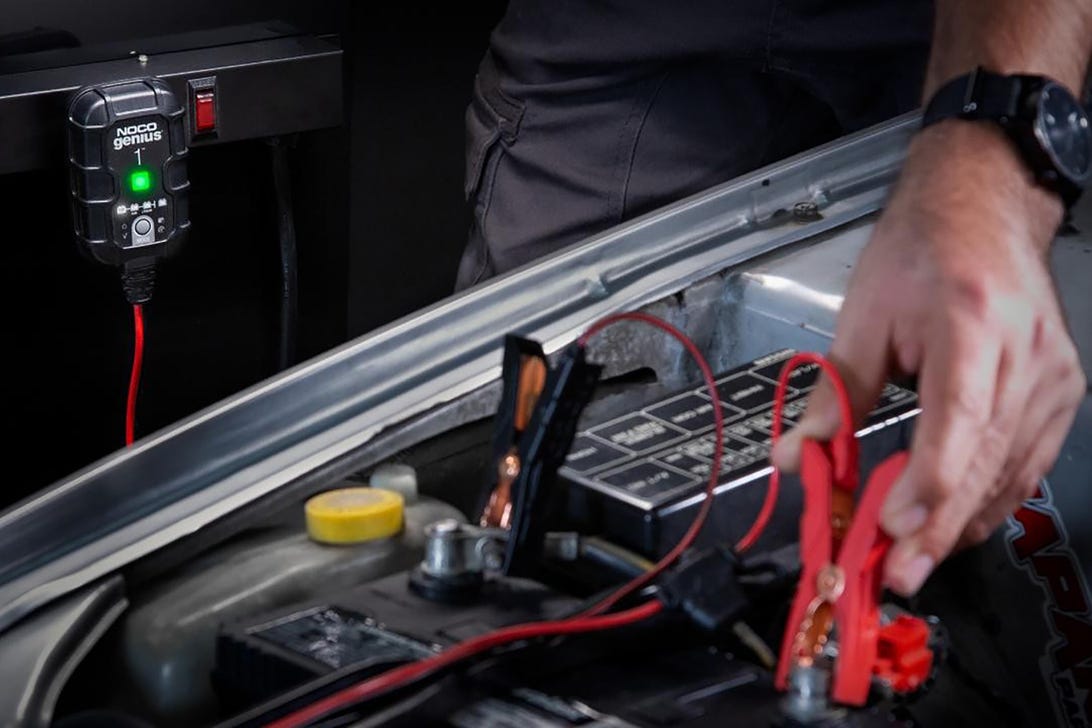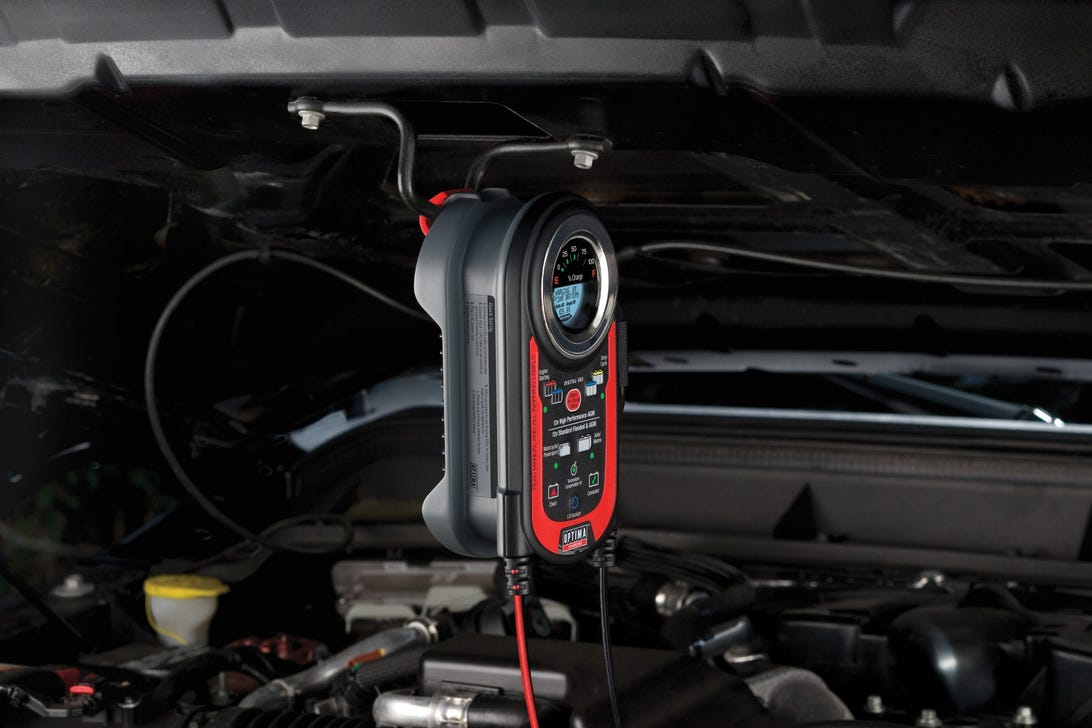Best car battery chargers for 2021 – Roadshow [CNET]
Thanks to cell phones, it’s easier than it used to be to get a tow or a jump. Still, no driver wants a dead battery. It can be a time-consuming and frustrating experience to have to wait for assistance — particularly when you have somewhere you need to go.
The good news is that a portable battery charger can help to keep your car fully functional and avoid the hassles that come with a dead battery, like trying to flag down a helpful stranger or waiting for someone to show up with jumper cables. A portable battery charger is also smaller than you might think, and it’s much easier than jump starting since you don’t have to string bulky cables from one vehicle to another. But that’s not all.
“A jump starter provides a lot of amperage (to start the car), and thus they are rather rough on batteries,” says Mike Arman, an electronics expert, vocational school teacher, and author of Motorcycle Electrics Without Pain. Arman has built fuel injection systems and wired countless cars, motorcycles and airplanes.
“You are much better off putting it on a regular charger and being patient (if possible). If your car needs repeated jump starts, the battery may be bad or there may be a problem with the charging system,” Arman says.
That said, if you’re going to pick up a portable battery charger, you want to make sure it’s the right one. Here’s a list of some of the best car battery chargers, depending on your specific needs, and based on user reviews and expert opinions. And make sure to read on for a deeper dive into the different types of car battery chargers.
Read more: Best battery maintainers in 2021
Comparison of the best car battery chargers
| Brand | Model | Price | |
| Best car battery charger overall | Battery Tender | Plus | $60 |
| Best car battery charger on a budget | NOCO | Genius1 | $30 |
| Best car battery charger for home use | Schumacher | SC1281 | $129 |
| Best car battery charger for long-term storage | Battery Tender | Junior | $25 |
| Best car battery charger for dead batteries | Optima | Digital 400 | $100 |
| Best car battery charger for fast charging | Schumacher | SC1325 | $192 |
| Best car battery charger for RVs | CTEK | 40-206 MXS 5.0 | $84 |
When shopping for a car battery charger you’ll have to decide if you want a manual or automatic charger.
CTEKAs a rule, it’s better for a vehicle’s battery to be charged slowly than quickly, if you can spare the time. “A jump start or using a fast charger on modern cars can fry all kinds of delicate electronics, and then you may be looking at some real money,” says Arman. “Modern cars are actually computers which just happen to have some wheels attached. You can do thousands of dollars of damage to the electronics if you are careless or sloppy with jump starts or quick chargers.”
A slow charge can be accomplished with a trickle charger. Trickle chargers come in both automatic and manual varieties, and are designed to recharge batteries slowly, over longer periods of time.
Automatic trickle chargers are effective for vehicles that will go unused for several months at a time, as they can offset the natural rate of self-discharge that the batteries experience. The self-discharge adds up, and can potentially drain your battery entirely by the time you try to use your vehicle again. Since these chargers are automatic, they’ll only fill up enough to compensate for the small amount of battery life that’s discharged before turning off again.
You can leave automatic trickle chargers plugged in, due to their safety features. “If the battery charger is plugged into a grounded wall outlet and attached properly, you can leave the charger attached until the battery is fully charged,” says Lauren Fix, creator of Car Coach Reports. Fix is a television and radio host and auto columnist who has been featured on Forbes, Inside Edition and ABC.com. “A top-quality charger will have a shut off when it reaches a fully charged status.”
If you need to charge a battery and you’re short on time, the Schumacher SC1325 is the charger for you.
SchumacherYour charger will come with detailed instructions that should be followed, but there are a few rules that are more or less universal (again, though, included instructions should supersede everything else). To start, you’ll always want to make sure that your charger is off — otherwise, you’ll risk subjecting yourself to an electric shock. Then, you’ll connect the charger’s positive clamp to the battery’s positive terminal and the charger’s negative clamp to the battery’s negative terminal. Usually, the charger’s positive clamp will be red and the negative clamp will be black.
After the charger is connected to the battery, individual instructions may vary. Some chargers may have settings to adjust that will determine the rate at which the battery is refilled, while others can just be turned on. Either way, at this point you’ll be ready to start charging.
The amount of time you’ll need to take to fully charge your battery depends on the existing charge level and the rate of your charger. Let’s say you have a 12-volt battery that holds about 48 amps of power. If your battery is completely drained and your charger can replenish 4 amps per hour, a full charge will take 12 hours. If your charger has an adjustable amperage rate, you can determine how long it will take to fully charge. Again, it’s better to charge your battery slowly, but in the event that you need a quick charge, you can set your device to a high rate. Just make sure that you keep an eye on it if it’s a manual charger in order to prevent overcharging.
If a vehicle is in long-term storage, charge the battery every 30 days or put it on a battery maintainer.
Schumacher5 thing you need to know before you buy a car battery charger
- What kind of battery type does your vehicle use? Most likely, the answer is a regular lead-acid battery, but if you drive an RV, it probably has a deep-cycle battery. In any event, you’ll have to make sure any charger you consider is compatible with your battery.
- Do you want a manual or automatic smart battery charger? Automatic chargers are typically easier to use, as they regulate their charge to prevent battery-damaging overcharging, but manual chargers are better for reviving dead batteries.
- How much power do you need in a charger? Do you want one that charges a battery slowly and keeps it maintained while it’s not in use? Or do you want a charger that can power up a battery quickly and possibly provide a jump start, as well?
- What size battery charger do you prefer? Though all of the models on the list are technically portable chargers, some are much larger than others and might therefore be more difficult to use. More powerful chargers are generally larger.
- What do you want to spend on a battery charger? Again, there’s typically a direct relationship between the power provided and the cost of the unit, so if you want to charge more quickly, you’ll need to spend a bit more.
Written by Scott Fried for Roadshow.

![best-car-battery-chargers-for-2021-–-roadshow-[cnet]](https://i0.wp.com/upmytech.com/wp-content/uploads/2021/05/29472-best-car-battery-chargers-for-2021-roadshow-cnet.jpg?resize=800%2C445&ssl=1)



![the-rising-cost-of-pregnancy:-what-can-parents-do-about-it?-–-cnet-[cnet]](https://i0.wp.com/upmytech.com/wp-content/uploads/2022/12/101742-the-rising-cost-of-pregnancy-what-can-parents-do-about-it-cnet-cnet.jpg?resize=390%2C205&ssl=1)
![‘obi-wan-kenobi’:-when-does-episode-3-drop-on-disney-plus?-–-cnet-[cnet]](https://i0.wp.com/upmytech.com/wp-content/uploads/2022/05/69030-obi-wan-kenobi-when-does-episode-3-drop-on-disney-plus-cnet-cnet.png?resize=390%2C205&ssl=1)
![fire-hype:-want-to-retire-early?-not-so-fast-–-cnet-[cnet]](https://i0.wp.com/upmytech.com/wp-content/uploads/2022/10/89341-fire-hype-want-to-retire-early-not-so-fast-cnet-cnet.png?resize=390%2C205&ssl=1)